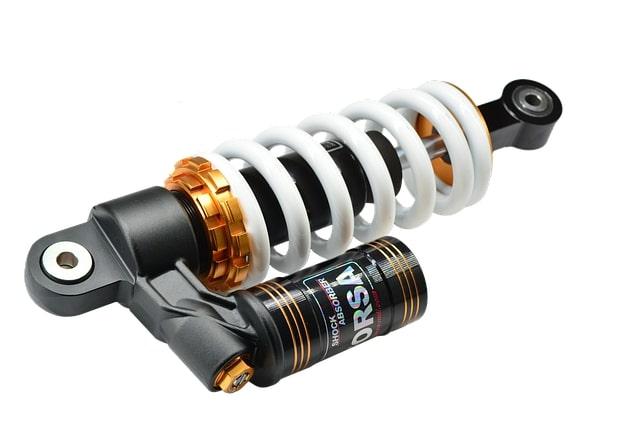Leakage is one of the alarming signs of replacing Shock Absorbers. Usually, most vehicles run thousands of miles pretty well before their shocks start to leak. You must have a clear view of what is causing the leakage; how much to spend; the dangers associated with leaking shock absorbers and all the consequences.
Oil leakage from your shock absorbers indicates that the hydraulic system inside the shock has been damaged. The oil/fluid in a normal shock should never leak, as it provides lubrication and absorbs the heat energy that is dissipated. When this happens you must get new Shock absorbers for your vehicle.
Working Principle of a Shock Absorber

The shock absorbers are the most essential components of your suspension system. Whatever be the type of your shock, inside the hard structure, there is a piston moving up and down whenever your tires are hitting road bumps. For energy conversion purposes and for reducing friction, hydraulic fluid is introduced here. This fluid is the core element of your shock.
Let’s take a brief look at its working principle.
- Whenever the vehicle is hitting any bump, say a speed breaker or potholes or even when the vehicle is traveling on an uneven road, the tires are facing vibrations from the bumps which are transmitted to the Shock.
- The kinetic energy of the vibrations is converted into mechanical energy which drives the piston up and down.
- The movement of the piston causes friction and produces heat.
- The heat energy is absorbed by the Hydraulic fluid inside the Shock. Thus the energy is dissipated and the tires don’t bounce like crazy when you hit bumps.
So, you can easily comprehend how much importance this hydraulic oil has in ensuring your smooth ride. Even if there is less oil, the energy dissipation wouldn’t occur properly and you would feel every bump on the road. That is why the leakage of oil is a big issue.
So Why Is the Oil Leaking?
- The vehicle should travel smoothly for thousands of miles. Sometimes, there may be slight leakage from the seals. But it is quite normal. When you move your finger through the body of the shell case, you will see some dry dust build-up on your finger and a little oil. This is not dangerous and doesn’t fall under significant oil leakage.
- But at one point there is too much leakage. When you move your finger this time, you will see a thick layer of oil deposit with greasy dust on your finger. This is alarming.
- It so happens that the top seal is not a complete or perfect seal. It may break easily or become fragile. So, oil can seep out through this defect easily and flow outside the shell case.
- Also, when the vehicle travels more on bumpy roads, the oil inside the shock may become more heated and thus expand in volume. When it expands, it starts to leak through the top seal.
- Your shock loses its cushion effect significantly when 8-10% of the oil/fluid leaks. Insufficient oil hampers the dampening effect of shock and your vehicle bounces no less than a kid’s bouncer!
Red Flag Signs to Understand Leakage
Besides obvious leakage, your vehicle may be showing many other signs suggestive of future leakage. Check for these signs whenever you feel your car is bouncing more than usual :
- Deformed tires: Tire surface becomes uneven. May be depressed in places.
- The Classical Bounce Test: Apply a considerable amount of weight on the front or back of your car by your hand. The car is supposed to bounce once or twice and then stabilize. If the car bounces more than twice, the shocks have probably worn out. This test is more reliable to check the rear shocks.
- Unusual noises coming from the front or back of your car.
- The steering wheel vibrates The steering wheel wobbles back and forth when hitting bumps.
- Obvious leaking shock absorbers: There is leakage of a great amount of oil that flows halfway across the body of the tube.
- Nose-diving: More important to predict front shock leakage.
- Increased Braking distance: When you apply brake after hard acceleration, the vehicle travels a few meters more before it stops.
- Excessive body rolls: Whenever your car is turning on a corner, it tends to lean more on one side, that is, there are excessive body rolls.
- Build-ups: Dirt, dust, grease, grits, grime, etc. may deposit on your shocks.
- Dents on the shell case.
- Damaged or broken parts.
See also: How Long Does It Take For “New Struts” To Settle?
How Often Do You Need to Check Your Shocks?
It all depends on how you are using your vehicle and for what purposes. If you travel more on bumpy roads, it’s quite obvious that the shocks have to work more, and the spring has to compress-decompress more. Generally, until the shocks start to show bad signs, they complete about a million cycles.
If you use your vehicle as a load carrier, it’s not unusual that the shocks show oil leakage even before its time. However, as a general rule, it’s better to be under supervision as per the following:
- Most experts suggest a routine thorough check-up after every 12 months. Statistically, it has been seen that when vehicles are treated well, most shocks stay good until a year.
- Some others have suggested a range of distance rather than time. Because the geography of your roads varies from place to place. In this context, it has been recommended to check after every 12, 000 – 15, 000 miles.
How Far Can the Vehicle Go Without Replacing Leaking Shocks?
- If the leakage is more, your vehicle won’t be able to ensure smooth rides for long. Furthermore, what is more, important than a smooth ride is your life. Accidents are very common with damaged or leaking Shocks.
- Although we recommend you to change it immediately whenever you notice a considerable amount of leakage, you may be able to travel nearly a thousand more miles until it’s totally damaged.
Can You Drive a Car Without Replacing the Leaking Shocks?
It’s not wise to do so, as your life may get endangered. But if you are lucky enough, it won’t affect you much given your vehicle has to endure fewer bumps.
- 9 out of 10 customers have reported that when they tried to keep using the vehicle without replacing the leaking shocks, they experienced very uncomfortable rides. The car bounced so much that they would often hit their heads on the roof while traveling on uneven surfaces.
- They also talked about all the red flag signs which interfered with the ride comforts. It’s really not safe and we strongly suggest you change your shocks with brand new ones.
What to Keep in Mind While Changing Shocks?
It’s better to check some points beforehand:
- Always buy from a reputable brand.
- Check for reviews from customers who have used them earlier.
- Make it cost-effective.
- Don’t go on buying hand-me-downs or inauthentic shocks. This is no less than spending a penny on a money pit.
- Double-check the parts and the structure.
- Spend wisely, so you don’t have to spend thousands on faulty manufacturers.
How Much Does It Cost to Replace Shocks?
Shocks are the inevitable parts of your vehicle. The cost varies from brand to brand and the model of your vehicle. Spend your valuable money wisely!
- Roughly, a single shock ranges from 30$ to 140$. But experts always recommend replacing shocks in pairs.
- Buying a pair may cost you from 60$ to 300 $
- It is best to get it done by a mechanic. As a beginner, you may not be expert enough to understand how the different parts work. Rather than going to the mechanic with a broken piece, it’s better to let them handle the matter. As they say, prevention is better than cure.
- But if you have done a few replacements yourself successfully then you may go for it!
- Doing it yourself will cost less. On the other hand, a mechanic may charge you from 300$ to 600$.
Consequences of Leaking Shock Absorbers
Leakage can bring out many dangers. It is life-threatening and harmful to your vehicle as well.
- A damaged shock absorber is not only harmful to your vehicle but also a threat to your safety.
- The bad noise or nuisance created may be quite embarrassing while driving new passengers.
- A bumpy ride doesn’t feel nice either and is as bad as it sounds. Your brain is programmed to expect a smooth safe ride and that is what you should expect from any vehicle. It is very disturbing when you start to feel every bump in the road.
- Oil leakage may cause greasy build-ups on the vehicle which is not only hard to clean but also very disgusting. When it spreads to other places, it becomes very difficult to clean all the parts.
- Instability of the vehicle can be a big issue when traveling high roads or taking turns on the corner.
- The continuously wobbling steering wheel is uncomfortable enough.
- All in all, the vehicle loses its control and the cushion effect that normal shocks are supposed to provide to your vehicle.
When to Change Your Shocks?
A good shock absorber can last longer than you know if you take proper care. Below are some points you must consider:
- When you start noticing the red flag signs it’s suggested you get new shocks. Usually, it happens after 40, 000 – 60, 000 miles.
- But then again, if you treat your vehicle poorly, the outcome will be poor as well. There will be premature shock failure and premature leakage.
- Treat your vehicle well, take good care of it, look for the signs, and always keep your vehicle on a routine thorough check-up.
Conclusion
A leaking shock absorber is often a common problem. Most people do not know how to deal with it and end up buying bad shocks. It’s important you do your research properly and get a good shock.
More resources:

